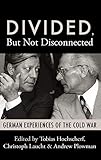Divided, But Not Disconnected : German Experiences of the Cold War / ed. by Tobias Hochscherf, Andrew Plowman, Christoph Laucht.
Material type: TextPublisher: New York ; Oxford : Berghahn Books, [2010]Copyright date: ©2010Description: 1 online resource (276 p.)Content type:
TextPublisher: New York ; Oxford : Berghahn Books, [2010]Copyright date: ©2010Description: 1 online resource (276 p.)Content type: - 9781845457518
- 9781845456467
- A940.5318
- D804.348 .H647 2008
- online - DeGruyter
| Item type | Current library | Call number | URL | Status | Notes | Barcode | |
|---|---|---|---|---|---|---|---|
 eBook
eBook
|
Biblioteca "Angelicum" Pont. Univ. S.Tommaso d'Aquino Nuvola online | online - DeGruyter (Browse shelf(Opens below)) | Online access | Not for loan (Accesso limitato) | Accesso per gli utenti autorizzati / Access for authorized users | (dgr)9781845456467 |
Frontmatter -- Contents -- Acknowledgements -- Abbreviations -- Introduction -- 1 Divided, but Not Disconnected: Germany as a Border Region of the Cold War -- 2 Fighting the First World War in the Cold War: East and West German Historiography on the Origins of the First World War, 1945–1959 -- 3 The Sideways Gaze: The Cold War and Memory of the Nazi Past, 1949–1970 -- 4 Recasting Luther’s Image: The 1983 Commemoration of Martin Luther in the GDR -- 5 West German Labour Internationalism and the Cold War -- 6 The German Question and Polish–East German Relations, 1945–1962 -- 7 From Bulwark of Freedom to Cosmopolitan Cocktails: The Cold War, Mass Tourism and the Marketing of West Berlin as a Tourist Destination -- 8 Projections of History: East German Film-Makers and the Berlin Wall -- 9 Defending the Border? Satirical Treatments of the Bundeswehr after the 1960s -- 10 East versus West: Olympic Sport as a German Cold War Phenomenon -- 11 Films from the ‘Other Side’ The Infl uence of the Cold War on the West German Feature Film Import in the GDR -- 12 The Shadows of the Past in Germany: Visual Representation, the Male Hero and the Cold War -- 13 Reenacting the First Battle of the Cold War: Post-Wall German Television Confronts the Berlin Airlift in Die Luftbrücke – Nur der Himmel war frei -- 14 Unusual Censor Readings: East German Science Fiction and the GDR Ministry of Culture -- 15 Funerals in Berlin: The Geopolitical and Cultural Spaces of the Cold War -- Select Bibliography -- Notes on Contributors -- Index
restricted access online access with authorization star
http://purl.org/coar/access_right/c_16ec
The Allied agreement after the Second World War did not only partition Germany, it divided the nation along the fault-lines of a new bipolar world order. This inner border made Germany a unique place to experience the Cold War, and the “German question” in this post-1945 variant remained inextricably entwined with the vicissitudes of the Cold War until its end. This volume explores how social and cultural practices in both German states between 1949 and 1989 were shaped by the existence of this inner border, putting them on opposing sides of the ideological divide between the Western and Eastern blocs, as well as stabilizing relations between them. This volume’s interdisciplinary approach addresses important intersections between history, politics, and culture, offering an important new appraisal of the German experiences of the Cold War.
Mode of access: Internet via World Wide Web.
In English.
Description based on online resource; title from PDF title page (publisher's Web site, viewed 25. Jun 2024)


